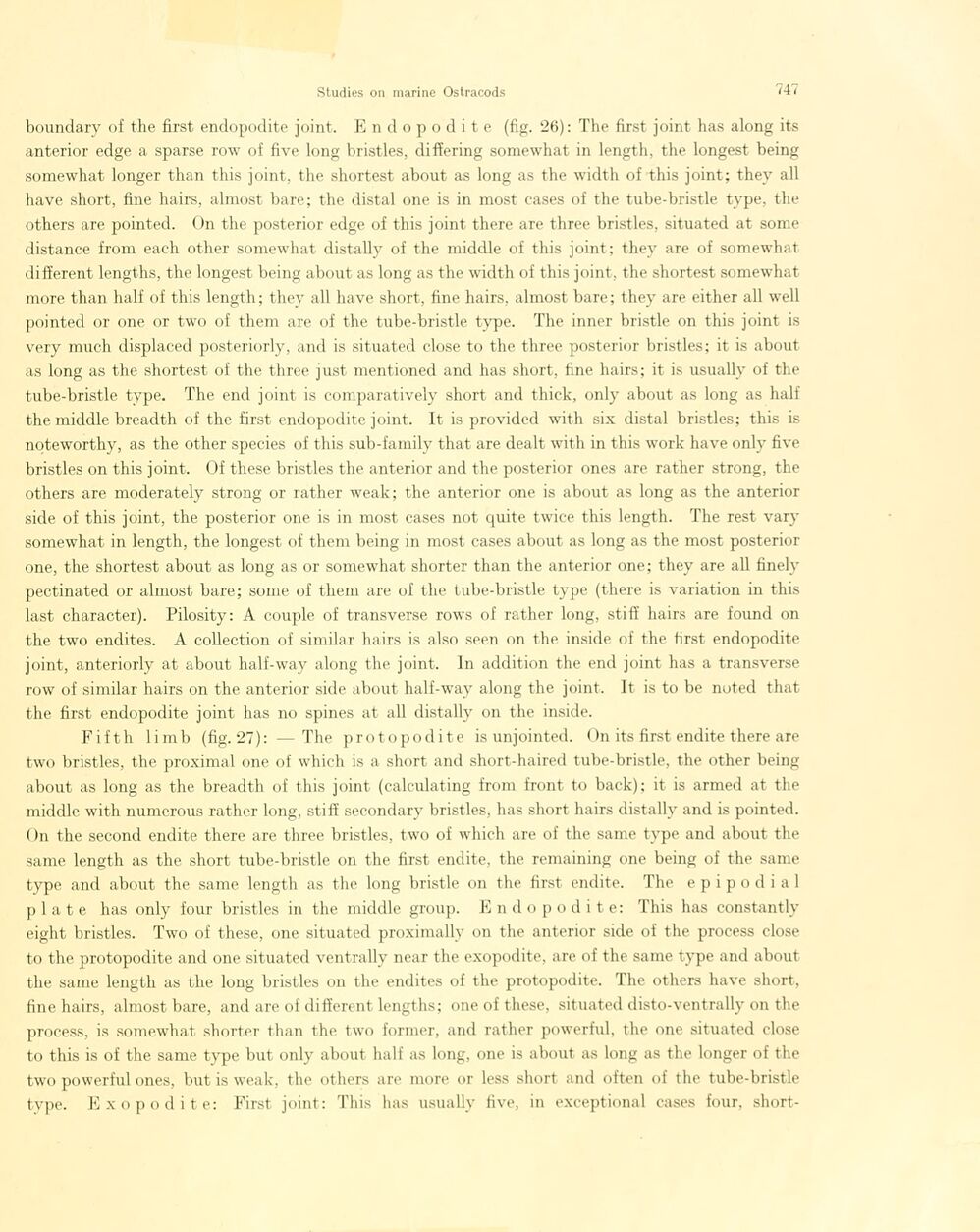
Full resolution (JPEG) - On this page / på denna sida - Sidor ...

<< prev. page << föreg. sida << >> nästa sida >> next page >>
Below is the raw OCR text
from the above scanned image.
Do you see an error? Proofread the page now!
Här nedan syns maskintolkade texten från faksimilbilden ovan.
Ser du något fel? Korrekturläs sidan nu!
This page has never been proofread. / Denna sida har aldrig korrekturlästs.
boundary of the first endopodite joint. Endopodite (fig. 26): The first joint has along its
anterior edge a sparse row of five long bristles, differing somewhat in length, the longest being
somewhat longer than this joint, the shortest about as long as the width of this joint; they ail
have short, fine hairs, almost bare; the distal one is in most cases of the tube-bristle type, the
others are pointed. On the posterior edge of this joint there are three bristles, situated at some
distance from each other somewhat distally of the middle of this joint; they are of somewhat
different lengths, the longest being about as long as the width of this joint, the shortest somewhat
more than half of this length; they all have short, fine hairs, almost bare; they are either all well
pointed or one or two of them are of the tube-bristle type. The inner bristle on this joint is
very much displaced posteriorly, and is situated close to the three posterior bristles; it is about
as long as the shortest of the three just mentioned and has short, fine hairs; it is usually of the
tube-bristle type. The end joint is comparatively short and thick, only about as long as half
the middle breadth of the first endopodite joint. It is provided with six distal bristles; this is
noteworthy, as the other species of this sub-family that are dealt with in this work have only five
bristles on this joint. Of these bristles the anterior and the posterior ones are rather strong, the
others are moderately strong or rather weak; the anterior one is about as long as the anterior
side of this joint, the posterior one is in most cases not quite twice this length. The rest vary
somewhat in length, the longest of them being in most cases about as long as the most posterior
one, the shortest about as long as or somewhat shorter than the anterior one; they are all finely
pectinated or almost bare; some of them are of the tube-bristle type (there is variation in this
last character). Pilosity: A couple of transverse rows of rather long, stifï hairs are found on
the two endites. A collection of similar hairs is also seen on the inside of the first endopodite
joint, anteriorly at about half-way along the joint. In addition the end joint has a transverse
row of similar hairs on the anterior side about half-way along the joint. It is to be noted that
the first endopodite joint has no spines at all distally on the inside.
Fifth limb (fig.27): —The protopodite is unjointed. On its first endite there are
two bristles, the proximal one of which is a short and short-haired tube-bristle, the other being
about as long as the breadth of this joint (calculating from front to back); it is armed at the
middle with numerous rather long, stiff secondary bristles, has short hairs distally and is pointed.
On the second endite there are three bristles, two of which are of the same type and about the
same length as the short tube-bristle on the first endite, the remaining one being of the same
type and about the same length as the long bristle on the first endite. The e p i p o d i a 1
plate has only four bristles in the middle group. Endopodite: This has constantly
eight bristles. Two of these, one situated proximally on the anterior side of the process close
to the protopodite and one situated ventrally near the exopodite, are of the same type and about
the same length as the long bristles on the endites of the protopodite. The others have short,
fine hairs, almost bare, and are of different lengths; one of these, situated disto-ventrally on the
process, is somewhat shorter than the two former, and rather powerful, the one situated close
to this is of the same type but only about half as long, one is about as long as the longer of the
two powerful ones, but is weak, the others are more or less short and offen of the tube-bristle
type. Exopodite: First joint: This has usually five, in exceptional cases four, short-
<< prev. page << föreg. sida << >> nästa sida >> next page >>